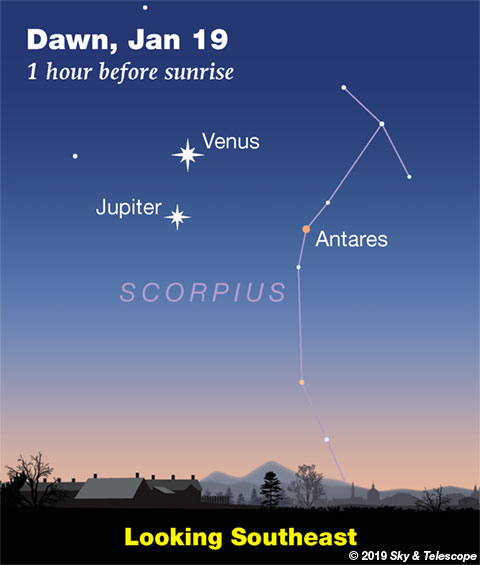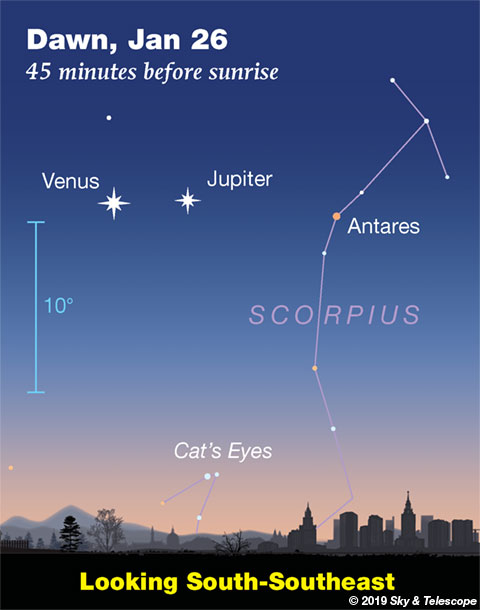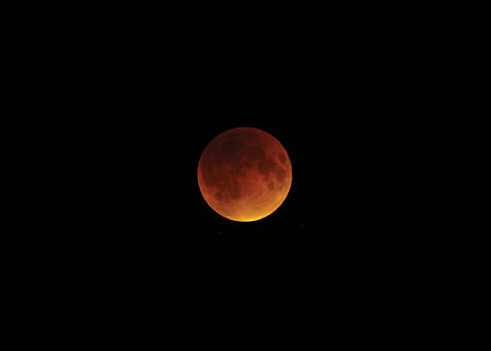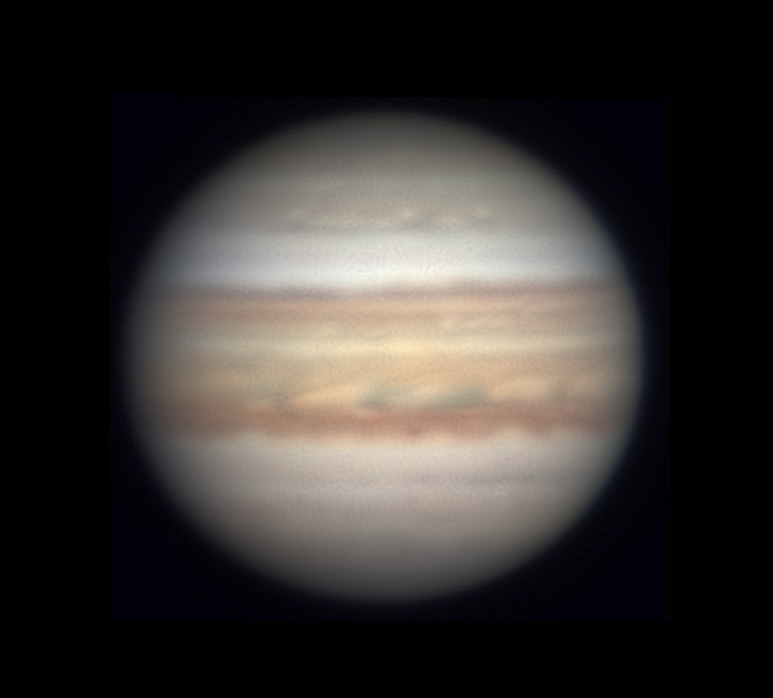

Friday, January 18
• Zero-magnitude Capella on high, and equally bright Rigel in Orion's foot, have almost the same right ascension. This means they cross your sky’s meridian at almost exactly the same time: around 9 or 10 p.m. now, depending on how far east or west you live in your time zone. So, whenever Capella passes its very highest, Rigel always marks true south over your landscape, and vice versa.
And tonight, the bright Moon shines between them.
Saturday, January 19
• The Moon shines in Gemini this evening, with Castor and Pollux to its left, Betelgeuse farther to its right, and Procyon down below.
• After dinnertime, Sirius twinkles brightly under Orion in the southeast. Around 8 or 9 p.m., depending on your location, Sirius shines precisely below fiery Betelgeuse in Orion's shoulder. How accurately can you time this event for your location, perhaps using the vertical edge of a building? Of the two, Sirius leads early in the evening; Betelgeuse leads later.
Sunday, January 20
• Full Moon, and total eclipse of the Moon high in a dark sky over the Americas. Partial eclipse begins at 10:34 p.m. EST, total eclipse begins at 11:41 p.m. EST, totality ends at 12:44 a.m. EST, partial eclipse ends at 1:51 a.m. EST. The eclipsed Moon will be in dim Cancer, with the Beehive star cluster about a binocular field-of-view to its east.

See the timetable for your time zone, and things to watch for throughout, in Bob King's Guide to January’s Supermoon Total Lunar Eclipse or the cover story of the January Sky & Telescope. Prefer audio? Here's our special podcast for the eclipse by that voice of Sky & Telescope, Kelly Beatty.
For most of Europe and Africa, the Moon will set around sunrise on the 21st either during totality or during the final partial phases, although westernmost Europe — including the British Isles — and northwestern Africa will be treated to the whole show before the Moon sets and the Sun rises.
Cloudy where you are? Watch the Virtual Telescope Project's livestream of the eclipse.
Monday, January 21
• Venus, which has been approaching Jupiter for many days, appears closest to Jupiter tomorrow morning the 22nd. They'll be about 2½° apart in early dawn. And look for fainter Antares 8° to Jupiter's right.
Think photo opportunity! Attach your camera or phone to a tripod, move around to frame the planet pair with some foreground scenery, and zoom in. Do it before dawn gets too bright!
Tuesday, January 22
• This is the time of year when the Northern Cross plants itself upright on the northwest horizon just after dark. Its top star is 1st-magnitude Deneb.
Wednesday, January 23
• The Gemini twins lie on their sides on winter evenings, left of Orion. Their head stars, Castor and Pollux, are farthest from Orion, one over the other. (Castor is on top.) The Castor figure's feet are just left of the top of Orion's dim Club.
Thursday, January 24
• With the waning gibbous Moon now gone from the early evening sky, is your sky dark enough for you to see the winter Milky Way? After dinnertime it runs vertically and across the zenith: from bright Canis Major low in the southeast, up between Orion and Gemini, through Auriga and Perseus almost straight overhead, and down through Cassiopeia, Cepheus, and Cygnus (including the Northern Cross) to the northwest horizon.
And take advantage of these dark evenings to explore telescopic sights high overhead with Sue French's Deep-Sky Wonders column, "Meridian Observing," in the January Sky & Telescope, page 54.
Friday, January 25
• Right after dark, face east and look very high. The bright star there is Capella, the Goat Star. To the right of it, by a couple of finger-widths at arm's length, is a small, narrow triangle of 3rd and 4th magnitude stars known as "the Kids." Though they're not exactly eye-grabbing, they form a never-forgotten asterism with Capella.
Saturday, January 26
• Orion is high in the southeast right after dark, and he stands highest due south around 10 p.m. Orion is the brightest of the 88 constellations, but his main pattern is surprisingly small compared to some of his dimmer neighbors. The biggest of these is Eridanus the Euphrates River just to his west, enormous but hard to trace. Dimmer Fornax the Furnace, to Eridanus's lower right, is almost as big as Orion! Even the main pattern of Lepus, the Hare cowering under Orion's feet, isn't much smaller than he is.
________________________
Want to become a better astronomer? Learn your way around the constellations. They're the key to locating everything fainter and deeper to hunt with binoculars or a telescope.
This is an outdoor nature hobby. For an easy-to-use constellation guide covering the whole evening sky, use the big monthly map in the center of each issue of Sky & Telescope, the essential guide to astronomy.

Once you get a telescope, to put it to good use you'll need a detailed, large-scale sky atlas (set of charts). The basic standard is the Pocket Sky Atlas (in either the original or Jumbo Edition), which shows stars to magnitude 7.6.
Next up is the larger and deeper Sky Atlas 2000.0, plotting stars to magnitude 8.5; nearly three times as many. The next up, once you know your way around, are the even larger Interstellarum atlas (stars to magnitude 9.5) and Uranometria 2000.0 (stars to magnitude 9.75). And read how to use sky charts with a telescope.
You'll also want a good deep-sky guidebook, such as Sue French's Deep-Sky Wonders collection (which includes its own charts), Sky Atlas 2000.0 Companion by Strong and Sinnott, or the bigger Night Sky Observer's Guide by Kepple and Sanner.
Can a computerized telescope replace charts? Not for beginners, I don't think, and not on mounts and tripods that are less than top-quality mechanically (meaning heavy and expensive). And as Terence Dickinson and Alan Dyer say in their Backyard Astronomer's Guide, "A full appreciation of the universe cannot come without developing the skills to find things in the sky and understanding how the sky works. This knowledge comes only by spending time under the stars with star maps in hand."
This Week's Planet Roundup

Mercury is hidden in the glare of the Sun.
Venus (magnitude –4.4) and Jupiter (magnitude –1.8) rise above the east-southeast horizon nearly two hours before the first light of dawn. They make a striking pair! By the time dawn begins to brighten, they dominate the southeast. They're 4½° apart on the morning of the 18th, with Venus on top. They pass each other, 2.4° apart, on the morning of the 22nd. By the 26th Venus is 4° to Jupiter's left.
They're in southern Ophiuchus. But about 8° to the right of Jupiter look for twinkly orange Antares, the leading light of Scorpius. At magnitude +1.0 it's not nearly as eye-catching.
In a telescope Venus appears just about at dichotomy: a dazzling little half-moon. The disk of Jupiter appears half again as large, but its surface brightness is some 50 times dimmer due to Jupiter's 7-times-greater distance from the illuminating Sun.
Mars (magnitude +0.7, in Pisces left of the Great Square of Pegasus) still glows high in the southwest at nightfall and sets around 11 p.m. In a telescope it's gibbous and pathetically small: 6½ arcseconds from pole to pole.
Saturn is hidden deep in the glow of sunrise.
Uranus (magnitude 5.8, at the Aries-Pisces border) is high in the south-southwest right after dark. It's visible in binoculars if you have a good finder chart and if you know the constellations well enough to see where to start with the chart.
Neptune (magnitude 7.9, in Aquarius) is getting low in the southwest right after dark. Finder charts.
______________________
All descriptions that relate to your horizon — including the words up, down, right, and left — are written for the world's mid-northern latitudes. Descriptions that also depend on longitude (mainly Moon positions) are for North America.
Eastern Standard Time (EST) is Universal Time (UT or GMT) minus 5 hours.
______________________
Audio sky tour. Outside under the evening sky with your earbuds in place, listen to Kelly Beatty's monthly podcast tour of the heavens above. It's free.
______________________
"Rational and innocent entertainment of the highest kind."
— John Mills, 19th century Scottish manufacturer and founder of Mills Observatory, on amateur astronomy.
______________________
 7
7








Comments
Rod
January 18, 2019 at 7:45 am
mary beth, it does look like I will be able to view the total lunar eclipse now and also the close conjunction of Jupiter and Venus, early morning of 22-Jan. Sunday night for me, temps will be 10F or -12C near eclipse time with winds from NW gusting 20-30 mph. We have snow and ice over the fields so I plan to stay on my back sidewalk area. Too risky carrying a good telescope across fields covered with snow and ice and with gusty winds howling all around. The Moon will be high up near 70-71 degrees elevation or altitude when I view so easy viewing angle. I plan to post a note on Bob King's eclipse report and here for Jupiter and Venus view later. Hope you see and enjoy the total lunar eclipse too.
You must be logged in to post a comment.
mary beth
January 18, 2019 at 11:04 pm
Glad you’ll be able to see, hope you don’t get uncomfortable out there for that long! We are forecast clear skies. Low about 40....cold but ok! We will have yo update each other Monday a.m.! Here’s to clear sky and eclipses!
You must be logged in to post a comment.
Rod
January 21, 2019 at 2:19 am
mary beth - this was a great total lunar eclipse! Some details on Bob King report. Temps were -10C when viewed tonight with winds 320/20 knots, gusting 30 knots at times. Very clear skies for most of the event though.
You must be logged in to post a comment.
Rod
January 22, 2019 at 8:56 pm
mary beth, were you able to view the total lunar eclipse and early this morning, Venus and Jupiter close conjunction, about 2.5 degrees apart before sunrise?
You must be logged in to post a comment.
mary beth
January 22, 2019 at 10:23 pm
Hello Rod! Enjoyed your eclipse story! I don’t know if I would have been able to stay outside for the whole thing in your area of the country. I was able to watch it here, crystal clear and about 40°F. Just a beautiful sight! Wish you could see Canopus, it’s brilliant and low due South. I spent a lot of time stargazing as well, it was so pretty to have the Gemini twins and Procyon in the field of vision of the moon.
I wish I had known about the conjunction, I guess I missed reading about it. Bet it was spectacular ! It might’ve been too cloudy here because we’ve had clouds all day. Houston is a very cloudy city unfortunately and so much light pollution.
OK so what’s the next big event??
You must be logged in to post a comment.
Rod
January 23, 2019 at 12:32 am
mary beth, glad to hear you observed the total lunar eclipse. In Maryland, I thought at times I was in the movie 'Everest' or 'The Day After Tomorrow' 🙂 *next big event*? It could be Venus and Saturn in early morning sky of 18-Feb. They will be close to 1.1 degree apart. For my location, a good viewing time is near 0615 EST, both will be up near 15 degrees altitude and 134 degrees azimuth in Sagittarius. There will be a 3rd magnitude star near Venus too, Pi Sagittarii or Albaldah. Venus and the star are < 18' angular separation. I should be able to view all 3 in my lower power field of view using my telescope (31x with 1.6 degree true field of view). Venus and Jupiter were excellent this morning. I viewed near 0630 EST using my telescope at 71x with 1 degree true field of view. Temperature was 9 degrees F or -13C but little wind so not bad - compared to the viewing of the total lunar eclipse. Using my telescope at 71x with 1 degree true field of view - the total lunar eclipse was a spectacular sight but brutal observing conditions 🙂
You must be logged in to post a comment.
mary beth
January 23, 2019 at 2:20 pm
You were quite brave and dedicated for staying out there! It is amazing though how you don’t feel the cold as brutally , even just standing there, if you’re concentrating on something. The beauty just takes over all your feelings! Oh I forgot to mention that I think it’s really neat you saw a shooting star during the eclipse!
You must be logged in to post a comment.
You must be logged in to post a comment.